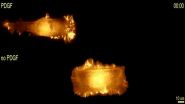(Press-News.org) BUFFALO, N.Y. – It is not only prenatal drug exposure, but also conditions related to drug use that can influence negative behavior in children, according to a new study from the University at Buffalo's Research Institute on Addictions.
In examining the long-term effects of cocaine use during pregnancy in a sample of low-income, cocaine-exposed and non-exposed families, researchers found that a mother's harshness toward her child during mother-child interactions at 2 years of age is one of the strongest predictors of problem behaviors in kindergarten, such as fighting, aggression and defiance.
Rina Das Eiden, PhD, the study's principal investigator, is conducting a multi-year study on the direct and indirect effects of prenatal drug use, following more than 200 mother and child pairs. It is funded by the National Institute on Drug Abuse.
Maternal harshness, such as threats of physical discipline, can be influenced by drug use. Animal studies have shown that prenatal cocaine use can affect parenting by lowering the bonding hormones mothers usually experience after birth, resulting in less emotional engagement with the child.
"Although prenatal cocaine exposure clearly can have negative health effects on children, the behavior problems may not only be due to what happens in the womb, but also to the effects of cocaine use on the mother," Eiden says. "Higher maternal harshness in cocaine-using mothers could also be due to other unmeasured variables, such as the mothers' own childhood experiences.
"Women who use cocaine have a harder time helping their children learn to self-regulate their behavior in the preschool years, which can lead to more negative behavior in kindergarten," she says.
A downloadable photo of Eiden is available here: http://www.buffalo.edu/news/releases/2014/10/006.html.
Other risks factors shown to negatively affect behavior of all children in this low-income sample are a higher likelihood of hunger and living in communities that regularly experience violence.
Eiden says parenting interventions in high-risk family situations while children are young may help reduce maternal harshness and promote self-control in children.
INFORMATION:
The study, published in a recent edition of Psychology of Addictive Behaviors, was co-authored by Claire Coles, PhD, Emory University School of Medicine; Pamela Schuetze, PhD, SUNY Buffalo State; and Craig Colder, PhD, UB professor of psychology.
RIA is a research center of the University at Buffalo and a national leader in the study of alcohol and substance abuse issues. RIA's research programs, most of which have multiple-year funding, are supported by federal, state and private foundation grants. Located on UB's Downtown Campus, RIA is a member of the Buffalo Niagara Medical Campus and is a key contributor to UB's reputation for research excellence. To learn more, visit buffalo.edu/ria.
Mother's behavior has strong effect on cocaine-exposed children
2014-10-06
ELSE PRESS RELEASES FROM THIS DATE:
Are Montana's invasive fish in for a shock?
2014-10-06
A new paper from the Wildlife Conservation Society, Montana State University, Montana Department of Fish, Wildlife and Parks, and the U.S. Geological Survey looks at the feasibility of electrofishing to selectively remove invasive trout species from Montana streams as an alternative to using fish toxicants known as piscicides that effect all gill-breathing organisms.
Westslope Cutthroat Trout (WCT) have experienced severe declines throughout much of their historical range. One major reason for this decline is the current competitive advantages enjoyed by non-native Brook ...
Controlling Ebola in communities is critical factor in containing outbreaks
2014-10-06
Reducing community transmission and changing behaviour in communities is key to containing Ebola outbreaks, according to new research into the first known outbreak of the virus in 1976 by researchers at the London School of Hygiene & Tropical Medicine and Fogarty International Center at the National Institutes of Health.
The study authors include Professor Peter Piot and Dr Joel Breman, who travelled to Zaire (now the Democratic Republic of Congo), to investigate the first outbreak in 1976. The study, published in Epidemics, also found that if the people in the affected ...
Study of identical twins reveals type 2 diabetes clues
2014-10-06
By studying identical twins, researchers from Lund University in Sweden have identified mechanisms that could be behind the development of type 2 diabetes. This may explain cases where one identical twin develops type 2 diabetes while the other remains healthy.
The study involved 14 pairs of identical twins in Sweden and Denmark. One twin had type 2 diabetes and the other was healthy.
"Twins are a good model for finding mechanisms, but the results are applicable to all", said Emma Nilsson, who carried out the study with Charlotte Ling.
We know that fat tissue can ...
Link between breast implants and cancer under investigation
2014-10-06
Worldwide there have been 71 documented cases of patients with anaplastic large cell lymphoma (ALCL) in which researchers suspected breast implants to be the cause. ALCL is normally found in the lymph nodes, as well as in skin, lung, liver and soft tissue, but not usually in the breast. Cases in which ALCL developed in the breast region almost exclusively involved patients who have had breast surgery. In these cases, ALCL developed around ten years after the operation. The tumours grew in the scar tissue around the implant.
Breast implants are generally safe and studies ...
Atmospheric chemistry hinges on better physics model
2014-10-06
New theoretical physics models could help us better grasp the atmospheric chemistry of ozone depletion. Indeed, understanding photoabsorption of nitrous oxide (N2O) — a process which involves the transfer of the energy of a photon to the molecule — matters because a small fraction of N2O reacts with oxygen atoms in the stratosphere to produce among others nitric oxide (NO). The latter participates in the catalytic destruction of ozone (O3). Now, new theoretical work unveils the actual dynamic of the photoabsorption of nitrous oxide molecules. These findings by Mohammad ...
Basel scientists are bringing cells on the fast track
2014-10-06
VIDEO:
The cell stimulated with the growth factor PDGF (upper cell) migrates targeted in only one direction on its track, while the not stimulated cell (lower cell) changes its direction of...
Click here for more information.
During cancer metastasis, immune response or the development of organisms, cells are moving in a controlled manner through the body. Researchers from the Department of Biomedicine at the University of Basel discovered novel mechanisms of cell migration by ...
Liquid DNA behind virus attacks
2014-10-06
Viruses can convert their DNA from solid to fluid form, which explains how viruses manage to eject DNA into the cells of their victims. This has been shown in two new studies carried out by Lund University in Sweden.
Both research studies are about the same discovery made for two different viruses, namely that viruses can convert their DNA to liquid form at the moment of infection. Thanks to this conversion, the virus can more easily transfer its DNA into the cells of its victim, which thus become infected. One of the studies investigated the herpes virus, which infects ...
Nanoparticles break the symmetry of light
2014-10-06
This news release is available in German.
How can a beam of light tell the difference between left and right? At the Vienna University of Technology (TU Wien) tiny particles have been coupled to a glass fibre. The particles emit light into the fibre in such a way that it does not travel in both directions, as one would expect. Instead, the light can be directed either to the left or to the right. This has become possible by employing a remarkable physical effect – the spin-orbit coupling of light. This new kind of optical switch has the potential to revolutionize ...
Tumors might grow faster at night
2014-10-06
They emerge at night, while we sleep unaware, growing and spreading out as quickly as they can. And they are deadly. In a surprise finding that was recently published in Nature Communications, Weizmann Institute of Science researchers showed that nighttime is the right time for cancer to grow and spread in the body. Their findings suggest that administering certain treatments in time with the body's day-night cycle could boost their efficiency.
This finding arose out of an investigation into the relationships between different receptors in the cell – a complex network ...
Researchers redefine hypothesis on holes in the brain
2014-10-06
Over the years, researchers have described how some of the body's cells have giant channels – a kind of holes that completely uncritically allow both small and large molecules to penetrate into and out of the cell. The hypothesis is that these normally closed gatekeeper proteins in the cell membrane allow unrestricted access in the event of diseases such as myocardial infarction, stroke or Alzheimer's. If the hypothesis was correct, the obvious choice would be to look for novel drugs to block the relevant membrane proteins and in this way cure or prevent disease.
New ...


